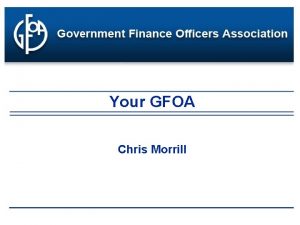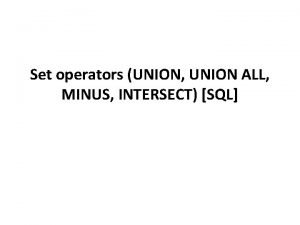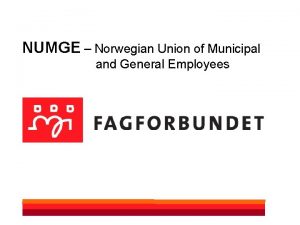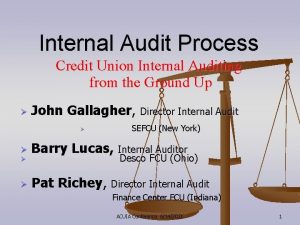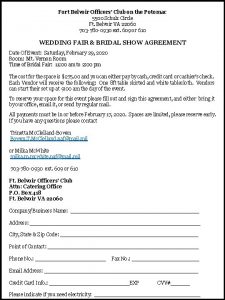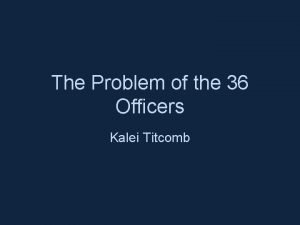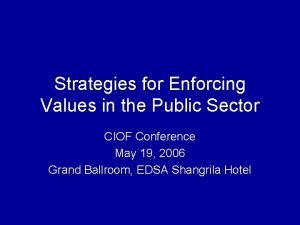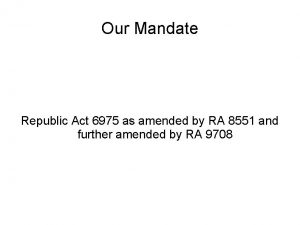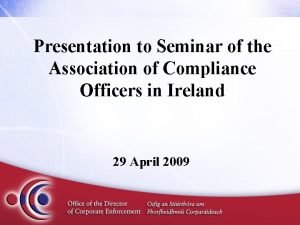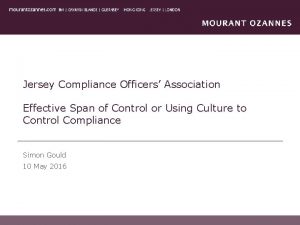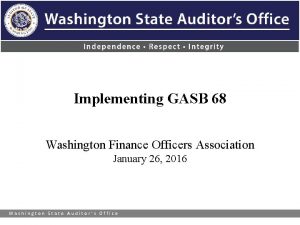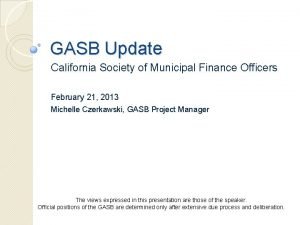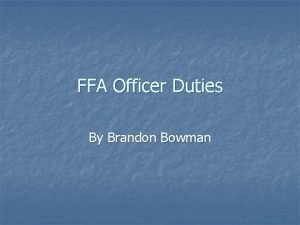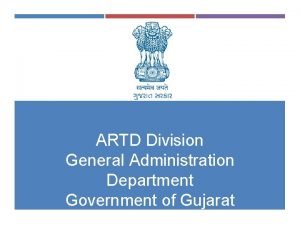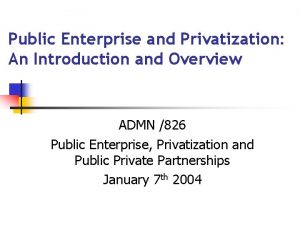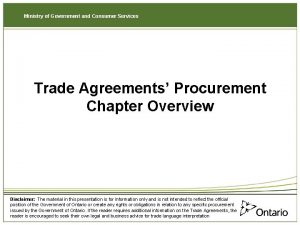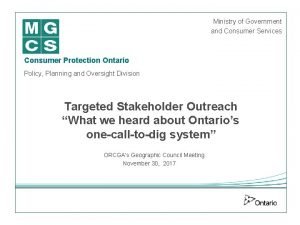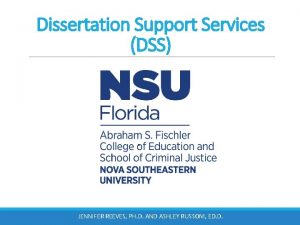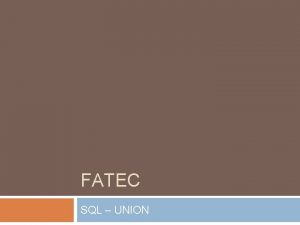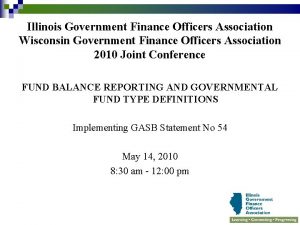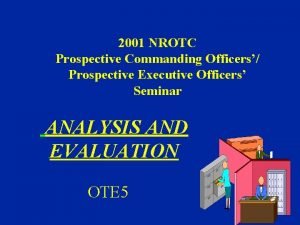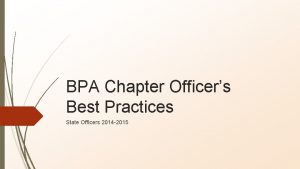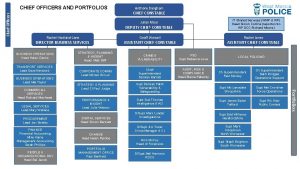GOVERNMENT GENERAL SERVICES UNION PREPARING MANAGEMENT SUPPORT OFFICERS
















































- Slides: 48

GOVERNMENT GENERAL SERVICES UNION PREPARING MANAGEMENT SUPPORT OFFICERS FOR OFFICE MANAGEMENT ASSISTANT PRESENTED BY F K YARROO MINISTRY OF HEALTH AND QUALITY OF LIFE (5754 6786) AUGUST / SEPTEMBER 2017

THE REGISTRY (SEPTEMBER 2017)

AGENDA � Communication flow in a Registry � Functions of a Registry � Filing � Movement of files � Storage of current files � Closed files and storage � Security of files � Missing files and ways to trace them � Correspondence and handling of mails � Flimsy � Computerised Registry � Maintaining the system � Benefits of a good Registry

AGENDA (CONT) � Components of a Registry – MMMIFF � How to manage the Registry (POLC – supervision) � Functions of the Registrar � Role played by a Registry �Link office �Post office �Training centre �Documentation centre �Archive �Facilitator �Information Manager

COMMUNICATION FLOW IN A REGISTRY

FUNCTIONS OF A REGISTRY ü The essential functions of a registry are to: Receive, record and distribute incoming and internally created mail of all kinds (such as letters, e-mails, memoranda and faxes); ü Open and index files, attach relevant papers and pass the files to action officers; ü Build up and control all officially registered files and other documentation in their care, so that they can be produced quickly by means of effective indexing, classification and tracking procedures; (cont)

FUNCTIONS OF A REGISTRY (CONT) ü Know the location of all officially registered files in their care and be able to produce them quickly, by means of effective indexing, classification and tracking procedures; ü Provide storage, repository and reference services for all officially registered files and other documentation in their care; ü Record and arrange for the efficient and timely despatch of all correspondence produced by the officers they serve; and ü Review and dispose of all inactive files or other records in accordance with the Archives Regulations.

WHAT IS A FILE ? � The registered file is an organised assembly of documents kept together for use, and relating to a specific subject, type of transaction or area of business. The registered file should have three components: • a cover to protect the contents and act as a title page and a record of the file‟s circulation; • the contents; and • some method of securing the whole together. � � Ø Ø Ø A file cover minimises damage from handling and use. It includes: a space for the name of the organisation, the file title/subject, file reference number, security marking and references to related files, a grid (or ladder) for recording the file‟s circulation when in use.

HOW TO CREATE A NEW FILE � Effective � In reading to identify subject matter case no file exist, create new file � Devise appropriate file title to reflect content � Proper indexing of newly created file � Entry in appropriate register � Insertion of reference number and title of any connected file � Filling of card for movement of file

OPENING A NEW FILE � The registry staff should ensure that a new volume is opened if the file becomes bulky and the volume number (Ex: vol 2, Vol 3 as applicable) is properly inserted on the file cover. � Generally, a file should not contain more than 100 folios. This is but a rough indication because if after 50 folios, a file becomes bulky, a new volume should be opened; on the other hand, a file may still not be bulky after 125 folios. � An appropriate index card should accordingly be made for the new volume of the file. � As a general rule, when a new volume of the same file is opened, the numbering of folios and minutes must be consecutive e. g. volume 2 should not start with folio (1) but with the number next after the last number of the previous volume.

FILING � Identify subject of correspondence � Punching of documents � Referencing/Numbering Files � Numbering of folio and enclosures, if any � Cross referencing of any correspondence mentioned in body of letter � Recording of correspondence in minute sheet � Using the “Transfer Slip” (in case of removal of a document and placed in another file). It is done under instruction only.

RECORDING THE EXISTENCE OF A NEW FILE � File created with appropriate title to reflect content � File reference number inserted on file cover � Prepare � Record Index card for newly created file reference number and title in file register

CONTROLLING FILE MOVEMENT Recording File Movement � Files are issued to action officers in at least three circumstances: • A document , when it reaches the registry, is recorded and filed, then the file is passed to the officer; • A file is to be “brought up”; and • The officer requests the file in person or by telephone. � Registry staff must be able to determine the location of every file for which they are responsible. Each time a file moves, this fact must be recorded in the registry. File movements are monitored in a number of ways: on file index cards, on transit ladders that appear on file covers, on file transit slips and through regular file audits.

FLAGGING OF FILES � The conduct of business at all levels is greatly eased by the correct use of flags which show at a glance the type of action required by the recipient or the urgency of the matter. � Flags should be used without fail whenever appropriate, either singly or in combination – e. g. a file containing an urgent draft should be flagged both “Urgent” and “Draft”, so that the flagging reads vertically: Draft Urgent Immediate Most immediate For signature For information Today Further Action Required(FAR) � � � �

HANDLING FILES RETURNED TO THE REGISTRY FOR DISPOSAL File returned to Registry will bear indication of either “Bring Up” (B. U) OR “ Put Away ” (P. A) � If file is to be “Bring Up” (B. U): v Record file reference number and title on appropriate date in “B. U. ” diary v Place “B. U” file in separate cabinet � If ü ü file is to be “ Put Away ” (P. A), Check: If no action is pending If no further action required, Dispose off file

CLOSING FILES AND USING THE RECORD CENTRE The method of closing a file is to write the word “CLOSED” diagonally in bold letters across the front cover, together with the date the file was closed. The file index card must be marked to show that the file has been closed. The date when this was done must also be recorded. However, before doing so, need to see whether the file has become too bulky. If so there is need to: � Open new volume of the file � Create index card for the new volume of the file � Mark previous volume as “CLOSED” � Store previous volume of file separately/ in records centre

THE REGISTRY AND THE LIFE OF RECORDS � Registries are concerned with all files –Active Files, Semi. Current Files as well as Closed Files. It is important, however, that registries know how and when to shift files on to the Records Centre. � The Records Centre provides a storage and retrieval service for semi-current records. Semi-current records are records that are no longer needed for day-to-day use but must be kept because they may need to be referred to occasionally or because they have a continuing administrative, legal and financial value. � By making regular use of the Records Centre, registry staff will be able to provide users of records with access to semi-current records that are no longer kept in the registry. Use of the Centre will also achieve improvements in working conditions, as they will keep the records registry clear of files not needed for current work.

CUSTODY OF CLOSED FILES Closed files should be kept available for a period of time so that users may easily refer to them. If action officers request closed files, the file movement should be recorded on the index card. � The retention period of closed files should be in accordance with the requirement/nature of activities of the organisation and may differ from one organisation to another. At the end of this specified period, closed files are disposed of, according to Archives procedures. � Weeding Procedures � Weeding of dead files should be considered as a routine operation. Without weeding, storage as well as retrieval problems arise. � Regular weeding of files (ex: annual)should be carried out jointly by the Officer in Charge of the registry and Management.

STORING REGISTERED FILES � Storing current files � Secure and well maintained accommodation � Sufficient and appropriate equipment � Adequate space in cabinets/ on shelves � Proper labeling of drawers/ shelves � Storing closed files � Draw list of closed files � Mark index cards � Shift closed files to separate location � Proper labeling of drawers/shelves

SECURITY OF FILES � Controlled access � Grading of files � Custody of confidential files � Use of photocopying machine � Use of fax machine � Custody of official seal

CORRESPONDENCE � Registry staff must deal promptly and accurately with many different kinds of correspondence. Incoming correspondence reaches the registry in a number of different ways. Some come by post, some by hand despatch, some by fax or electronic mail. � There also differences in the way in which items are addressed. Some will be addressed to a Ministry/Department and some to individuals either by name or by title of office. � Other items may be either inadequately or illegibly addressed. A smaller number of items will bear security or privacy markings, such as “confidential” or “personal". Some mail may contain cheques and other valuables which must be carefully recorded and accounted for in the registry.

FAX AND ELECTRONIC MAIL � Copy for circulation and original to action officer � When original is received place both in the appropriate file � Emails should be printed and placed in files as well as the replies made � If the mail deals with more than one subject copies need be made and paced in the relevant files

INCOMING CORRESPONDENCE � Incoming mail � Stamping of documents � Entries in incoming register � Screening of mail � Circulation of mail

INCOMING CORRESPONDENCE REGISTER AND MAIL FOLDER � After the mail has been opened and all enclosures accounted for, each letter must be registered by a designated officer in the Incoming Correspondence Register. • • • All columns of the register must be completed. The details to be entered initially are: date received date of correspondence reference number from whom the letter was received subject of the letter; and file reference number (to be filled in when letter is filed)

OPENING OF MAILS � Private and personal mails � Slitting of envelopes � Loose enclosures and missing enclosures � Certificates, deeds, cheques and other legal documents (not to be punched / kept separate and in safe place (cont)

OPENING OF MAILS (CONT) � Ø Ø � Ø Private and personal mail should be delivered to the respective persons unopened. If the mail is found to be general correspondence, it should be returned to the registry for recording. All other mail should be opened and date-stamped as soon as it is received by the registry. Slit envelopes across the top to open. Care must be taken to ensure the contents of letters are not damaged when the envelopes are slit. (cont)

OPENING OF MAILS (CONT) � Many Ø Ø enclosures are received loose or separated from their covering documents. Attach such enclosures to the relevant documents, taking care not to damage cheques, certificates or similar items. All attachments must be noted on the covering document. This is particularly important when the enclosures are valuable or are personal papers. � It Ø may happen that a document is received at the registry without the enclosures mentioned therein. If this is the case, the sending organisation/sender must be contacted immediately and a note inserted on the document. (cont)

OPENING OF MAILS (CONT) � Certificates, deeds, cheques and documents require special care. other legal Ø Such documents should not be punched. Place such documents in separate envelopes, noting the contents and the number of the file on the outside. Ø These are recorded in an Incoming Correspondence Register, then stored in a safe place and crossreferenced on the file.

HANDLING MAIL CONTAINING VALUABLES � Envelopes containing money orders or other valuable items must be carefully safeguarded from the time it is received and remitted to the action officer promptly for necessary action. � Registry staff should record the following information in the Paper Money Register: � • date received; � • name of person sending paper money; � • amount; � • cheque number; � • name and signature of officer opening remittance; and � • name and signature of officer receiving remittance.

CIRCULATION OF MAILS � Circulation list � Correspondence marked urgent � Correspondence requiring immediate action (copies are circulated). Originals for action to schedule officers. � Return of correspondence after circulation (cont)

CIRCULATION OF MAIL (CONT) � The Officer in Charge of the registry or a designated officer will decide how items are to be handled. Place letters in incoming mail folders for circulation to the most senior officers in the organisation together with incoming mail sheet The officers on the circulation list will vary from organisation to organisation, but it is important that the list is as short as possible so that the mail folder is returned to the registry quickly. � The officers on the circulation list should attend to the documents in the incoming mail folder promptly. They should mark those correspondence that they would like to deal with personally or that they would like referred to other officers for action. All such directions should be initialed and dated by the officer making them. Letters should normally not be removed from the mail folder. The registry should be kept informed in case any letter is removed from the incoming mail folder. (cont)

CIRCULATION OF MAIL (CONT) � Where there is more than one circulation of mail each day, correspondence delivered after a circulation has been despatched, should be held over and included in the subsequent batch. However, any correspondence that are marked “urgent” must be delivered immediately. � For letters which should be dealt with immediately, only copies of same should be placed in the incoming mail folder. (cont)

CIRCULATION OF MAIL (CONT) � The original copy of the letter should be sent promptly on file to the action officer for immediate action. � When the incoming mail folder is returned to the registry, place the documents immediately on the appropriate files. Before the files are passed to the action officers, registry staff should note on the relevant file index card and the file ladder on the front of the file, the title and the name of the action officer and the date the file is being referred to the officer.

OUTGOING CORRESPONDENCE � Verify � One letter dated signed and enclosures attached copy kept for circulation � Insert date of issue on file copy and initial � Proper addressing of envelope � Stamping � Make of envelope entry in outgoing register � Return file to action officer

FLIMSY FILE An extra copy of all the letters typed and signed is normally placed in chronological order in a file cover called “Flimsy File” which should generally be circulated on a daily basis or within one week. The file should not be too bulky with a view to enable the senior officer(s) to go through the file with ease. (cont)

FLIMSY FILE (CONT)- THE AIMS It enables: � (a) the Supervising Officer to ensure that instructions have been correctly interpreted by officers signing papers on his/her behalf; � (b) senior officers to know what is going on in the Ministry; and � (c) a record of outgoing papers without having to consult the despatch book or individual files. � The flimsy file may also prove helpful for the creation of temporary file in case the main file is unavailable whereby documents on the flimsy file could be used.

MISSING FILES � It is deplorable that files should ever be allowed to get lost and there altogether too many alleged to be missing. � To reduce the possibilities of files being lost, the following steps are to be taken: � (a) careful recording of the movement of every file, either internally or externally; � (b) regular follow-up to ensure that files circulated are being returned e. g once a month, the Officer in Charge should show each action officer a list of all the files which are on the latter‟s schedule which have been out for one month or more and seek instructions as to recall etc…; � (c) once a month, a list of files with each action officer should be drawn up and checked against a list of files recorded as marked out to those officers. Action should be taken immediately thereafter to resolve any discrepancies; and � (d) a list of all files for which registry cannot account should be drawn up. A central record should be kept of all files reported missing – in other words, a register of “Missing Files” should be opened and kept in the safe custody and responsibility of the Officer in Charge of the registry. � Registry staff /action officer should be careful when handling files and any loss of any official document may lead to a breach of security. (cont)

MISSING FILES – HOW TO TRACE? (CONT) � If a file is missing, the registry must proceed as follows: � • The Officer in Charge of the registry must contact the action officer to whom the file was last recorded in the file’s transit index cards and ask him/ her to trace it, i. e, the action officer may indicate to whom the file may have been sent without the registry having been informed of. � • If this fails or is impracticable, the Officer in Charge of the registry must circulate a note to all officers in the Ministry/Department asking them to check whether the file is in their possession. (cont)

MISSING FILES – HOW TO TRACE? (CONT) � If the file still cannot be found, a special search must be initiated by an officer with specific authority to ensure that the search is effective. The search must be repeated several times if necessary. � As soon as the registry staff learns that a file is missing and may be lost, they must write the words “missing file” on the relevant index card.

MISSING FILES – HOW TO TRACE? (CONT) � As soon as any file is found to be missing, the registry staff concerned should submit a report which should cover the following points to the Officer in Charge of the registry: (a) file reference and title; (b) when found to be missing and by whom; (c) last recorded movement; and (d) steps taken to trace.

. MISSING FILES – HOW TO TRACE? (CONT) � The Officer-in-Charge of the registry will consider what further action might be taken to trace the file. If and when he/she is satisfied that no further action is practicable, he/she should submit the report to the designated Security Officer or other senior officer in charge of Administration through the action Officers who should in due course consider whether they agree with the conclusions of the Officer in Charge of the registry. �A list of missing files should be maintained by the Officer in Charge, periodic searches carried out and a record kept of the areas searched.

TEMPORARY FILES If action on a topic covered by a missing file continues, open a temporary file. This should only be done if absolutely necessary. � A temporary file may also be opened when the main file is with an officer and letters requiring action in the same file remain unattended. � A temporary file is opened in the same way as a normal file. It is given the same reference number as the missing file and its existence is recorded in the normal way. If available, temporary file covers should be used. � If temporary file covers are unavailable, a standard file cover should be used but must be boldly marked with the word „TEMPORARY‟. All relevant record sheets should be similarly marked. � No temporary file should be opened without the authorisation of the Officer in Charge of the registry. �

TEMPORARY FILES (CONT) To incorporate a temporary file into a main file: � Remove ALL contents from the temporary file jacket and place in main file. Insert as last folio/minute in the main file; � Note, in the margin of the minute sheet, the date the merging was effected; and � Part of the movement of the file on the cover of the Temporary file should be affixed on the verso of the front cover of the main file with a note of the date of the merging. Note: � A temporary file needs not necessarily be merged with a main file. The bulkiness of both files should be considered for merging.

COMPUTERISED THE REGISTRY � Computerisation has proved to be one of the means for rendering the registry more efficient. The benefits could be more apparent in big Ministries/Departments where the volume of transaction is large. � Benefits Ø Ø Ø of a Computerised system No use of index card No use of incoming mail register No use of "B. U" diary Quick location of files Easy search of mails Quicker response to query

MAINTAINING THE SYSTEM � Regular weeding of files � No eating and drinking in registry � No smoking in registry � Regular cleaning � Regular pest control � Maintainance of files

BENEFITS OF A GOOD REGISTRY The registry is the nerve centre of any Ministry/Department. No Ministry/Department can function effectively unless the registry is functioning efficiently. A good registry provides control of records and presents several benefits: � � Efficiency – records are better organised and located, therefore making them quickly retrievable, thereby facilitating ease of reference, eradicating staff frustrations and increasing productivity. � �Consistency – the existence of documented policies means that staff members execute actions relative to records in a consistent manner. (cont)

BENEFITS OF A GOOD REGISTRY (CONT) � Good decision making – staff members have ready access to all necessary records, they are able to make decisions with reference to precedent, context and eventualities. � Enhanced image – improved efficiency and management enhance the image of the organisation for all stakeholders. � Ensures preservation of important records – while not for everyday use or operational purposes, archival records contribute significantly to the construction of collective memory and cultural heritage. � Continuity – good records facilitate continuity on occasions when staff members leave the employment of the organisation. In the absence of records, staff members take their knowledge with them when they leave.

THANK YOU
 Government general services union
Government general services union Georgia government finance officers association
Georgia government finance officers association Government investment officers association
Government investment officers association Sql union minus intersect
Sql union minus intersect Norwegian union of municipal and general employees
Norwegian union of municipal and general employees National government vs federal government
National government vs federal government Credit union internal auditing services
Credit union internal auditing services Berechs
Berechs Community college business officers
Community college business officers Fort belvoir officers club
Fort belvoir officers club Chief instructional officers california community colleges
Chief instructional officers california community colleges California community college chief instructional officers
California community college chief instructional officers International foundation for protection officers
International foundation for protection officers Uk chief medical officers' physical activity guidelines
Uk chief medical officers' physical activity guidelines 36 officers problem
36 officers problem Officers pledge
Officers pledge Short choppy sentences in the tell tale heart
Short choppy sentences in the tell tale heart I will love and serve god my country
I will love and serve god my country What were the military duties of ranked officers othello
What were the military duties of ranked officers othello Canton police officers
Canton police officers Training officers consortium
Training officers consortium Blue and gold basics ffa officers and meetings
Blue and gold basics ffa officers and meetings Association of compliance officers in ireland
Association of compliance officers in ireland Officers list
Officers list Police officers pledge
Police officers pledge Planning enforcement officers association
Planning enforcement officers association Cap blues uniform
Cap blues uniform Jersey compliance officers association
Jersey compliance officers association Blue and gold basics what is ffa
Blue and gold basics what is ffa Officers portal
Officers portal National association of school resource officers
National association of school resource officers Gasb
Gasb California society of municipal finance officers
California society of municipal finance officers Ffa officers and their duties
Ffa officers and their duties Example of major points
Example of major points Gujarat general administration department
Gujarat general administration department Strong surface tension
Strong surface tension Carroll
Carroll Advantages of privatization
Advantages of privatization Local government investment pool organization
Local government investment pool organization Local government investment pool services north carolina
Local government investment pool services north carolina Local government investment pool services north carolilna
Local government investment pool services north carolilna Ministry of government and consumer services
Ministry of government and consumer services Ministry of government and consumer services
Ministry of government and consumer services Abm government services
Abm government services +office 365 +microsoft +premier +support
+office 365 +microsoft +premier +support Ibm tss services
Ibm tss services 5 health care career pathways
5 health care career pathways Dissertation support services
Dissertation support services

